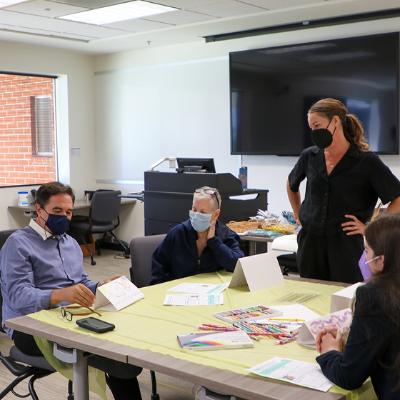
For Loyola Center for Conflict Resolution student Jake Carlis ’24, newly employed art therapy sessions have been transformative – not just for his clients, but for him and his supervising attorney.
Carlis, a student in LMU Loyola Law School’s Collaborative Family Law Clinic, explained that as part of his work with couples attempting to mediate their separation and custody arrangements, “I was tasked with eliciting details from the client about what they wanted to accomplish in that session. The art therapy worked in conjunction with the student attorneys' questions aimed at building an agenda. The art seemed to calm everything down and made asking tough questions easier” he said. “Art therapy has been very impactful.”
The first couple to try art therapy as clients in LMU Loyola Law School’s Collaborative Family Law Clinic included a large, muscular man who was suspicious of the method at first. He said he’d give it a try, but he asked LMU art therapy Professor Jessica Bianchi not to tell the other guys.
His assignment was to create a picture collage expressing his hopes for the day’s session mediating his divorce. When he was done, he told Bianchi, “I came in here feeling really negative about this experience, but after creating this piece of art, I feel a lot more hopeful.” He made an additional collage over lunch.
LLS students in the Collaborative Family Law Clinic have been helping under-represented families in Los Angeles use collaborative divorce mediation for about 10 years. In the collaborative approach, couples who promise to work together are aided by a team of lawyers and law students, financial counselors and mental health professionals.
This semester, Bianchi and her students joined the team. Bianchi is an assistant professor of marital & family therapy at LMU and the director of the university’s art therapy clinic.
Clinic director, Adjunct Professor Kevin J. Chroman, has been impressed. “It helps,” he said. “The couples are having better and calmer conversations. They tell their story and talk about their intentions for their family.”
Couples working with the family law clinic go through a compressed version of the usual collaborative mediation process, which can take months. Each spouse first meets with a lawyer and/or law student to understand the process and express what they hope to achieve in the mediation. At other points, they talk with a financial professional and with a mental health professional who acts as a “divorce coach.” The process concludes with the couple meeting together with the whole team to come to a collaborative agreement.
New this semester, the initial meeting with counsel also includes an art therapist and student. The spouses are given a large number of photos clipped from magazines, along with some drawing materials. “We invite them to create a collage about what they are hoping to get out of the day,” Bianchi said.
The therapists are purposeful in selecting the photos, which include images of families, children, nature, cities and objects such as timepieces and birds’ nests.
Bianchi said she and her colleagues have noticed that creating the collages gives the couples some control and choice at a time in their lives when they feel overwhelmed and unsure. The artworks help the spouses find common ground concerning their hopes, especially for their children, and it gives the team members a clear view of each client’s needs and goals. The spouses also are encouraged to use their art when presenting their individual opening mission statements during the final whole-team meeting. “It alleviates some of their anxiety because now they can talk about something other than themselves,” Bianchi said.
Carlis said he thinks the art therapy is successful. “I think it’s almost as important as any other piece of the collaborative model. It sets a tone of ‘we’re here for you.’”
And he knows it calms nerves. When asked to take the part of a divorcing husband in a mock collaborative mediation during an early training session, Carlis was nervous about his acting ability. “When I started doing the art therapy, I felt more relaxed,” he said.
Carlis isn’t sure if he’ll become a family lawyer. He’ll be clerking at the L.A. office of a national law firm next summer, but he’s sure his art therapy and collaborative mediation experiences will inform his future practice. “It’s definitely something that I will make a point to use,” he said.
Chroman said art therapy will now be a permanent part of his clinic. “I’ve been blown away by the weight, importance and creativity of the art therapy component within the program,” he said. “People really take to it. The art becomes a wonderful starting point for the conversations when we bring the two parents together.”